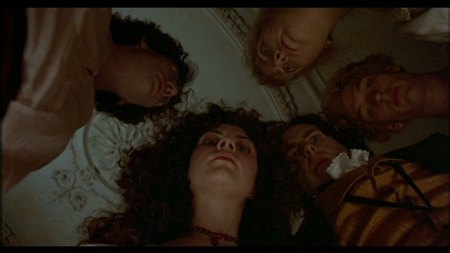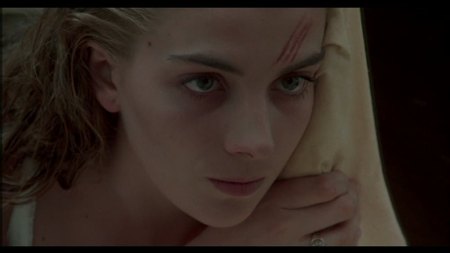Nights at the Villa Deodati #2: Phantasmagoria

I saw GOTHIC at the Cameo Cinema on its first release in 1986. I went alone. I watched alone — I don’t remember another soul being there, though I suppose there must have been somebody else in the audience. If Messrs. Golan & Globus had witnessed that matinée, they might have thought twice about bankrolling Ivan Passer’s HAUNTED SUMMER, which violated the law discovered by his fellow Czech filmmaker Milos Forman on VALMONT: “Never make a movie that somebody else has just made.”
In HAUNTED SUMMER, screenwriter Lewis John Carlino “solved” the problem of the fact that nothing much is known to have actually happened during the summer when Mary Shelley hatched the idea for Frankenstein by writing a historically faithful script in which nothing much happens. In GOTHIC, Stephen Volk, a writer who has shown an admirable devotion to the fantastique throughout his distinguished career, tackles the same problem in a number of ways —
- He folds into the story the characters’ backstories, so that dramatic events from their pasts can inform the action. Byron’s incestuous love for his sister and, crucially, the death of Mary’s first baby, are introduced via dialogue, some of it a bit awkwardly expository, and then can be played out in the ensuing psychodrama. Whatever the merits of the execution, the idea is a masterstroke, creating a human drama behind the authorial act which is our prime reason for being here — it’s unbelievable that the other movies on the subject neglect to do this.
- He also incorporates glimpses of the characters’ tragic futures, seen in psychedelic visions. This is also much more satisfying than HAUNTED SUMMER’s wrap-up, where a flurry of tragic deaths is dispensed with in a few titles at the end, leaving the odd impression that we’ve been watching the wrong scenes from the protagonists’ lives.
- By plunging the audience into the drug-induced paranoia of a frenzied laudanum party, Volk concocts a supernatural plotline in which a kind of séance seemingly unleashes all manner of hellspawn. I don’t think this is fully developed in narrative terms, perhaps because the barely-glimpsed monster is given short shrift compared to all the onscreen psychotronics, but it certainly gives rise to lots of good images.

Russell was returning to British cinema after an interesting American adventure which self-destructed with the barely-released CRIMES OF PASSION, from which the MPPAA cut around 40 mins (“They cut everything to do with art,” observed Ken.) I now look rather affectionately upon this penultimate phase of his career — I still can’t get on with the home video works that followed it, but I’ll speak up on behalf of LAIR OF THE WHITE WORM, SALOME’S LAST DANCE, and GOTHIC. Not so keen on THE RAINBOW, alas.
Russell was also giving interviews in which he extolled the virtues of the fast forward, saying he’d enjoyed RUMBLE FISH but that he’d watched it at double speed, which improved it. GOTHIC feels a bit like the script is on fast-forward, as if Russell couldn’t wait to get to the leaches and severed heads, and couldn’t be bothered allowing any of the characters to start breathing as human beings. A talented cast, plus Julian Sands, are left gasping for air with unformed lungs like poor Mary’s premature baby. They are ~
- The late, lamented Natasha Richardson. Her decision to give Mary a Scottish accent is surprising — Mary spent maybe a year and a half in Scotland, max. But alone among the cast she establishes a baseline of credibility — she doesn’t get space to develop it, but she’s always believable, even when required to disgorge implausible amounts of exposition.
- Julian Sands. Sands is good in some stuff. Not here. His Percy Bysshe Shelley alternates between acting as if he’s SHOUTING, while speaking at normal volume, and drawing the edges of his mouth as far back as possible, like a monkey in a wind tunnel, or a man attempting to eat a Wagon Wheel biscuit in one go. He’s supposed to become hysterical, but he’s already hysterical, and in the wrong sense of the word. Bysshe Bash Bosh.
- Gabriel Byrne. Naturally Byronic, but unimpressive stripped to the waist, incipient moobs aquiver. Suffers a bit from having Every Famous Thing Byron Ever Said as dialogue. Next to Sands he sounds like a genius though.
- Timothy Spall. Knows he’s in a Ken Russell film, so is playing it like Murray Melvin in THE DEVILS, but an MM who has been mysteriously inflated with methane.
- Myriam Cyr. The least-known one, and the most memorable, with her huge eyeballs. One of a harem of Russell lovelies who only made one indelible impression (Alita Naughton, Imogen Millais-Scott). Her sparse other credits include FRANKENSTEIN UNBOUND and FRANKENSTEIN AND ME. The woman’s clearly obsessed.

Every version of this story seems to feature one surprise unknown. In HAUNTED SUMMER it was Philip Anglim, whom we’d never seen before. At his first closeup, Fiona cruelly and hilariously remarked “No.” She was already smitten with Stoltz as Shelley. Later she admitted Anglim was pretty damn good. The best of the Byronic batch, actually.
“You’re not allowed to criticise the score,” said Fiona, a Thomas Dolby fan from way back. After five minutes, she was criticising it, or at any rate saying “The score is a disaster.” When the movie is prematurely hysterical, the score is a particular problem. Russell has lost his patience as a filmmaker, and patience is a form of courage — believing you can make the audience wait for something. So the movie isn’t scary, despite throwing everything at us. It’s frequently freaky, though.

The last act is where it all kicks in and starts working. Since the visual stuff works better than the talking headcases, it would be easy to give Russell all the credit, but he was careful to praise Volk’s script for the fact that it served up delicious images, more valuable than words. So Russell’s hectic tempo is responsible for some of the apparent writing flaws, and Volk’s visceral writing deserves some of the credit for the film’s feast of imagery. Mary Shelley in a timewarp, glimpsing the future, encapsulates the premise of FRANKENSTEIN UNBOUND in five minutes better than that movie manages in its whole runtime.
My favourite images —

Ken recreates his beloved Busby Berkeley’s Lullaby of Broadway sequence, only with a skull instead of Wini Shaw.
A bit of T & eye. Not frightening. But bizarre. (see top)
A simple closeup, utterly beautiful and more haunting than anything else we’ve seen.

To Russell, the cardinal sin was to bore, and on that basis, GOTHIC wins the Battle of the Byrons. But read on…
February 13, 2016 at 2:03 pm
Those eye boobs look exactly like the guild navigator from DUNE.
February 13, 2016 at 2:43 pm
That must be how space-time gets folded at the end of the movie!
February 13, 2016 at 5:05 pm
I take it that Eric Stoltz’s moobs are preferable to those of Gabriel Byrne? Pity!
February 13, 2016 at 5:55 pm
Myriam Cyr’s imdb page has a message board thread with the subject line “myriam cyr seen like she into frankenstien movies.”
February 13, 2016 at 7:48 pm
Stoltz is a bit scrawny, but has good muscle definition. Julian Sands is probably the best body beautiful among all these guys, but left Fiona unmoved.
February 13, 2016 at 10:02 pm
David, any thoughts on Russell’s WHORE? It’s always been one of my favourites of his.
February 13, 2016 at 10:42 pm
I have an old VHS of it but have never watched it. I think I started a couple of times, got a bad feeling, and bailed, but always felt I would have to come back to it at some point.
February 14, 2016 at 2:59 am
OMFG. Scalia is dead. Sorry — I find this so startling that I’m impelled to OMFG just everywhere.
Time to inform the cats.
February 14, 2016 at 5:38 am
I just checked Netflix to see what Ken Russell stuff is available and he made a movie about the Dreyfus Affair starring Richard Dreyfuss. !?!?
February 14, 2016 at 10:25 am
Yesm Prisoner of Honor was Russell’s penultimate collaboration with Oliver Reed (their last was a radio play where Olly played Crowley, very difficult for the dyslexic)
Richard Dreyfuss has grew up believing he was related to Alfred. But it’s not really a great role, so instead he plays the lawyer
It’s not a bad film, pretty good for what it is, although Lindsay Anderson (who also acts in the film) observed that it wasn’t really a Russell film.
There was apparently a lot of tension with Star/Producer Dreyfuss
http://articles.latimes.com/1991-10-27/news/tv-656_1_dreyfus-affair
February 14, 2016 at 12:02 pm
Russell was unhappy with the Prisoner of Honor experience because HBO blew up several shots to make closeups, whereas Russell had treated it as cinema and let the wide shots do their work.
But the piece is a little dull, considering the inherent drama of the story, and not really Ken’s kind of material.
Yes, the Scalia thing seems to be good news all round. One doesn’t like to exult in another human’s death, but the knock-on effects politically seem positive in the extreme.
February 14, 2016 at 7:08 pm
I was hoping the Dreyfus(s) thing was like the Coens casting Barry Pepper as Lucky Ned Pepper because “…He already had the Pepper thing nailed, and he just had to get up to speed on the Lucky Ned aspects of the character.”
February 14, 2016 at 7:11 pm
I remember Dreyfuss saying at the time, “There are actors who don’t want to work with Ken Russell and actors who do. I’ve always been one who does.” But it seems like he found that he switched category part way through the production…